
Use the resources below to create a report about a historical figure.
- Subject:
- Elementary Education
- Material Type:
- Lesson Plan
- Author:
- Jason O'Callaghan
- Date Added:
- 04/25/2019

Use the resources below to create a report about a historical figure.
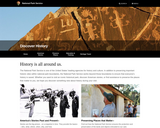
offers educators Park Service resources that help teach about our nation's cultural heritage, and which look at how the NPS is protecting and preserving them. Subjects include archaeology, historic buildings and structures, mapping, military history, and national historic landmarks. The resources may be in the form of learning programs, case studies, lesson plans, teachers' handbooks, and more.
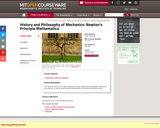
This course focuses on an in-depth reading of Principia Mathematica Philosophiae Naturalis by Isaac Newton, as well as several related commentaries and historical philosophical texts.
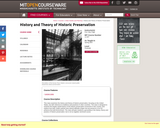
This class examines the history and theory of historic preservation, focusing on the United States, but with reference to traditions and practices in other countries. The class is designed to examine the largely untold history of the historic preservation movement in this country, and explore what laws, public policies and cultural attitudes shape how we preserve or do not preserve the built environment. The class will give students a grounding in the history, theory and practice of historic preservation, but is not an applied, technical course.
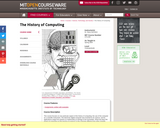
Examines the development of computing techniques and technology in the nineteenth and twentieth centuries, particularly critical evaluation of how the very idea of "computer" changes and evolves over time. Emphasis is on technical innovation, industrial development, social context, and the role of government. Topics include Babbage, Hollerith, differential analyzers, control systems, ENIAC, radar, operations research, computers as scientific instruments, the rise of "computer science," artificial intelligence, personal computers, and networks. Includes class visits by members of the MIT community who have made important historical contributions. This course focuses on one particular aspect of the history of computing: the use of the computer as a scientific instrument. The electronic digital computer was invented to do science, and its applications range from physics to mathematics to biology to the humanities. What has been the impact of computing on the practice of science? Is the computer different from other scientific instruments? Is computer simulation a valid form of scientific experiment? Can computer models be viewed as surrogate theories? How does the computer change the way scientists approach the notions of proof, expertise, and discovery? No comprehensive history of scientific computing has yet been written. This seminar examines scientific articles, participants' memoirs, and works by historians, sociologists, and anthropologists of science to provide multiple perspectives on the use of computers in diverse fields of physical, biological, and social sciences and the humanities. We explore how the computer transformed scientific practice, and how the culture of computing was influenced, in turn, by scientific applications.
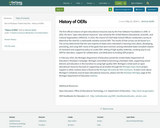
Part of #GoOpen Toolkit help files - History of OERs
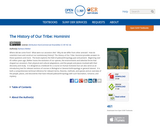
Where did we come from? What were our ancestors like? Why do we differ from other animals? How do scientists trace and construct our evolutionary history? The History of Our Tribe: Hominini provides answers to these questions and more. The book explores the field of paleoanthropology past and present. Beginning over 65 million years ago, Welker traces the evolution of our species, the environments and selective forces that shaped our ancestors, their physical and cultural adaptations, and the people and places involved with their discovery and study. It is designed as a textbook for a course on Human Evolution but can also serve as an introductory text for relevant sections of courses in Biological or General Anthropology or general interest. It is both a comprehensive technical reference for relevant terms, theories, methods, and species and an overview of the people, places, and discoveries that have imbued paleoanthropology with such fascination, romance, and mystery.
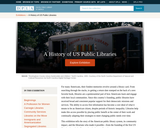
For many Americans, their fondest memories revolve around a library card. From searching through the stacks, to getting a return date stamped on the back of a new favorite book, libraries are a quintessential part of how Americans learn and engage with their local communities. Since this countrys founding, public libraries have received broad and consistent popular support for their democratic missions and services. The ability to access free information has become a core ideal of what it means to be an American citizen, despite periods of historic inequality. Libraries help make this access possible by placing public benefit at the center of their work and continually adapting their strategies to meet changing public needs over time. This exhibition tells the story of the American public library system, its community impact, and the librarians who made it possiblefrom the founding of the first US libraries through the first one hundred years of service. This exhibition was created as part of the DPLAs Public Library Partnerships Project in collaboration with partners and participants from Digital Commonwealth, Digital Library of Georgia, Minnesota Digital Library, Montana Memory Project, and Mountain West Digital Library.
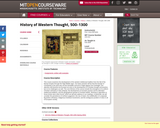
Examines the development of the western intellectual tradition from the fall of the Roman Empire through the High Middle Ages. Basic premise is that the triumph of Christianity in Europe was not the inevitable outcome it appears from hindsight. Attention is therefore focused not only on the development of Christian thought and practice, but on its challengers as well. Particular emphasis devoted to Nordic paganism, the rise of Islam, Byzantine orthodoxy, indigenous heretical movements, and the ambiguous position of Jews in European society.
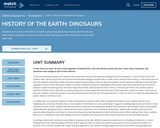
In this science/history-based unit, students learn about the history of the earth by studying fossils and dinosaurs. In the first part of the unit, students learn about how fossils are formed and how paleontologists study fossils in order to learn about ancient history. In the second part of the unit, students study what makes dinosaurs unique and fascinating creatures by learning about various species of dinosaurs and how they adapted in order to meet their basic needs for survival. Students will also be challenged to think about what earth was like at the time of the dinosaurs and how learning about dinosaurs helps them better understand the earth’s history. In the last part of the unit, students read a collection of fiction texts, each with a unique perspective on what happened to the dinosaurs and if dinosaurs really are extinct. In this part of the unit, students should be pushed to use what they have learned from the informational texts in order to confirm or deny the statements the author makes in the fiction texts.
In reading, this unit exposes students to both informational and fiction texts. When reading informational texts, students will focus on explaining the connection between two or more pieces of information in a text, particularly in regard to retelling how fossils are formed or how scientists uncover fossils. Students will also be pushed to describe the relationship between the illustrations and the text in which they appear, specifically describing what new or additional information they learn from reading the illustrations. Additionally, students will continue to practice determining the main topic of a text and asking and answering questions about unknown words. When reading fiction texts, students will focus on retelling the story and making connections between the story and the facts they’ve learned from the informational texts.
In writing, students will continue to write daily in response to the text. Written responses should focus on including an inference or critical thinking that shows understanding of the text and/or question and on using more words than pictures to communicate the answer to a question. This unit also includes two longer writing assignments: one research writing assignment and one narrative writing assignment.
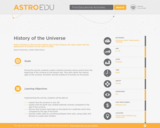
Students investigate how old the universe is and when important events took place in the universe and on Earth. They draw the universe timeline from the beginning until today on the scale of a year.
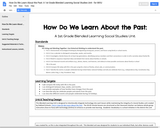
This Blended Learning Unit about how we learn about the past is designed to intentionally integrate technology into each lesson while maintaining the integrity of a Social Studies unit created by Oakland Schools, Unit 4: How Do We Learn About the Past. The 30-45 minute lessons are structured so the classroom teacher can balance whole group instruction (Face to Face) with technology (Online) to enhance or provide new learning. Academic Vocabulary is a school initiative in the district this unit was created for, so this is also integrated throughout the unit. This blended unit was also designed for students to use individual iPads, but other devices could be used as well.
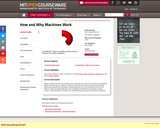
Subject studies how and why machines work, how they are conceived, how they are developed (drawn), and how they are utilized. Students learn from the hands-on experiences of taking things apart mentally and physically, drawing (sketching, 3D CAD) what they envision and observe, taking occasional field trips, and completing an individual term project (concept, creation, and presentation). Emphasis on understanding the physics and history of machines.
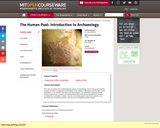
Archaeology reconstructs ancient human activities and their environmental contexts. Drawing on case studies in contrasting environmental settings from the Near East and Mesoamerica, considers these activities and the forces that shaped them. In laboratory sessions students encounter various classes of archaeological data and analyze archaeological artifacts made from materials such as stone, bone, ceramics, glass, and metal. These analyses help reconstruct the past. This class introduces the multidisciplinary nature of archaeology, both in theory and practice. Lectures provide a comparative examination of the origins of agriculture and the rise of early civilizations in the ancient Near East and Mesoamerica. The laboratory sessions provide practical experience in aspects of archaeological field methods and analytical techniques including the examination of stone, ceramic, and metal artifacts and bone materials. Lab sessions have occasional problem sets which are completed outside of class.

French Vocabulary Audio Clip He called himself the Sun King
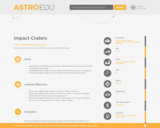
The students will learn about recent meteor strikes and the effects they can have. They will then examine their significance in the history of the planet, and what they do to the surface of a planet when forming a crater. The students will then experimentally determine how the size and impact velocity of a meteorite determine the size of the crater.
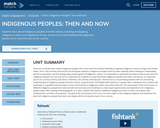
There are currently three million Indigenous people, from more than five hundred federally recognized Indigenous nations, living in the United States. Since 1492 and the arrival of the first European explorers, Indigenous people's land has been violently seized, leading to a devastating decline in population and the striping away of key aspects of Indigenous culture. It is impossible to synthesize the diverse history and culture of Indigenous people into one unit, but it is important for students to understand that Indigenous people have been, and still are, an important part of our country's history and future. Therefore, this unit has a few focuses. The first focus is on providing students with an overarching understanding of Indigenous people and their history, using the book The People Shall Continue as a guide. After reading the text, students will participate in a guided research project to learn more about an Indigenous nation near where they live. The second part of the unit focuses on different Indigenous people who have worked hard and overcome hardships to create equal opportunities and experiences for Indigenous people today. After reading a few biographies as a class, students will research additional Indigenous heroes to learn more about their achievements, sacrifices, and passions. The goal of the second part of the unit is to shine a light on key Indigenous figures and emphasize the idea that Indigenous people have been and always will be an important part of our country.

" This seminar has three purposes. One, it inquires into the causes of military innovation by examining a number of the most outstanding historical cases. Two, it views military innovations through the lens of organization theory to develop generalizations about the innovation process within militaries. Three, it uses the empirical study of military innovations as a way to examine the strength and credibility of hypotheses that organization theorists have generated about innovation in non-military organizations."
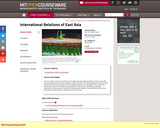
The aim of this course is to introduce and analyze the international relations of East Asia. With four great powers, three nuclear weapons states, and two of the world's largest economies, East Asia is one of the most dynamic and consequential regions in world politics. This course will examine the sources of conflict and cooperation in both periods, assessing competing explanations for key events in East Asia's international relations. Readings will be drawn from international relations theory, political science and history.
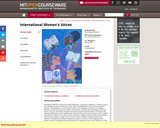
International Women's Voices has several objectives. It introduces students to a variety of works by contemporary women writers from Asia, Africa, the Middle East, Latin America and North America. The emphasis is on non-western writers. The readings are chosen to encourage students to think about how each author's work reflects a distinct cultural heritage and to what extent, if any, we can identify a female voice that transcends national cultures. In lectures and readings distributed in class, students learn about the history and culture of each of the countries these authors represent. The way in which colonialism, religion, nation formation and language influence each writer is a major concern of this course. In addition, students examine the patterns of socialization of women in patriarchal cultures, and how, in the imaginary world, authors resolve or understand the relationship of the characters to love, work, identity, sex roles, marriage and politics.This class is a communication intensive course. In addition to becoming more thoughtful readers, students are expected to become a more able and more confident writers. Assignments are designed to allow for revision of each paper. The class will also offer opportunities for speaking and debating so that students can build oral presentation skills that are essential for success once they leave MIT. The class is limited to 25 students and there is substantial classroom discussion.